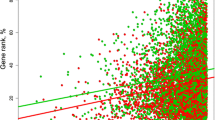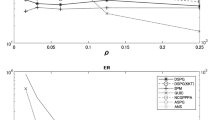Abstract
The problem of identifying key genes is of fundamental importance in biology and medicine. The GeneRank model explores connectivity data to produce a prioritization of the genes in a microarray experiment that is less susceptible to variation caused by experimental noise than the one based on expression levels alone. The GeneRank algorithm amounts to solving an unsymmetric linear system. However, when the matrix in question is very large, the GeneRank algorithm is inefficient and even can be infeasible. On the other hand, the adjacency matrix is symmetric in the GeneRank model, while the original GeneRank algorithm fails to exploit the symmetric structure of the problem in question. In this paper, we discover that the GeneRank problem can be rewritten as a symmetric positive definite linear system, and propose a preconditioned conjugate gradient algorithm to solve it. Numerical experiments support our theoretical results, and show superiority of the novel algorithm.
Similar content being viewed by others
References
Aerts S et al (2006) Gene prioritization through genomic data fusion. Nat Biotechnol 24: 537–544
Agarwal S, Sengupta S (2009) Ranking genes by relevance to a disease. Proc LSS Comput Syst Bioinform Conf 8: 37–46
Bai Z, Demmel J, Dongarra J, Ruhe A, van der Vorst H (2000) Templates for the solution of algebraic eigenvalue problems: a practical guide. SIAM, Philadelphia
Benzi M (2002) Preconditioning techniques for large linear systems: a survey. J Comput Phys 182: 418–477
Cipra B (2000) The best of the 20th Century: editors name top 10 algorithms. SIAM News 33(4)
Demmel JW (1997) Applied numerical linear algebra. SIAM, Philadelphia
Franke L et al (2006) Reconstruction of a functional human gene network, with an application for prioritizing positional candidate genes. Am J Hum Genet 78: 1011–1025
Freschi V (2007) Protein function prediction from interaction networks using a random walk ranking algorithm. IEEE international conference on bioinformatics and bioengineering, pp 42–48
Golub GH, Van Loan CF (1996) Matrix computations, 3rd edn. The Johns Hopkins University Press, Baltimore, London
Hai D, Lee W, Thuy H (2008) A PageRanking based method for identifying chracteristic genes of a disease. IEEE Int Conf Netw Sens Control 6–8: 1496–1499
Hestenes M, Stiefel E (1952) Methods of conjugate gradients for linear systems. J Res Natl Bur Stand 49: 409–436
Jia Z (1997) Refined iterative algorithms based on Arnoldi’s process for large unsymmetric eigenproblems. Linear Algebra Appl 259: 1–23
Ma X, Lee H, Wang L, Sun F (2007) CGI: a new approach for prioritizing genes by combining gene expression and protein–protein interaction data. Bioinformatics 23(2): 215–221
Morrison J, Breitling R, Higham D, Gilbert D (2005) GeneRank: using search engine for the analysis of microarray experiments. BMC Bioinform 6: 233–246
Page L, Brin S, Motwami R, Winograd T (1998) The PageRank citation ranking: bring order to the web, Technical report. Computer Science Department, Stanford University, Palo Alto
Saad Y (2003) Iterative methods for sparse linear systems, 2nd edn. SIAM, Philadelphia
Sharan R, Ulitsky I, Shamir R (2007) Network-based prediction of protein function. Mol Syst Biol 3: 1–13
Taylor A, Higham D (2008) CONTEST: a controllable test matrix toolbox for MATLAB. ACM Trans Math Softw 35, Article 26
The MATHWORKS, Inc. (2004) MATLAB 7. September
Wu G, Zhang Y, Wei Y (2010) Krylov subspace algorithms for computing GeneRank for the analysis of microarray data mining. J Comput Biol 17: 631–646
Wu G, Zhang Y, Wei Y (under review) Accelerating the Arnoldi-type algorithm for computing Google’s PageRank
Xenarios I, Salwinski L, Duan X, Higney P, Kim S (2002) DIP, the Database of Interacting Proteins: a research tool for studying cellular networks of protein interactions. Nucleic Acids Res 30: 303–305
Yue B, Liang H, Bai F (2007) Understanding the GeneRank model. IEEE 1st Int Conf Bioinform Biomed Eng 6–8: 248–251
Author information
Authors and Affiliations
Corresponding author
Additional information
Responsible editor: Pierre Baldi.
Dedicated to Prof. Zhi-hao Cao on the occasion of his 75th birthday.
Rights and permissions
About this article
Cite this article
Wu, G., Xu, W., Zhang, Y. et al. A preconditioned conjugate gradient algorithm for GeneRank with application to microarray data mining. Data Min Knowl Disc 26, 27–56 (2013). https://doi.org/10.1007/s10618-011-0245-7
Received:
Accepted:
Published:
Issue Date:
DOI: https://doi.org/10.1007/s10618-011-0245-7




